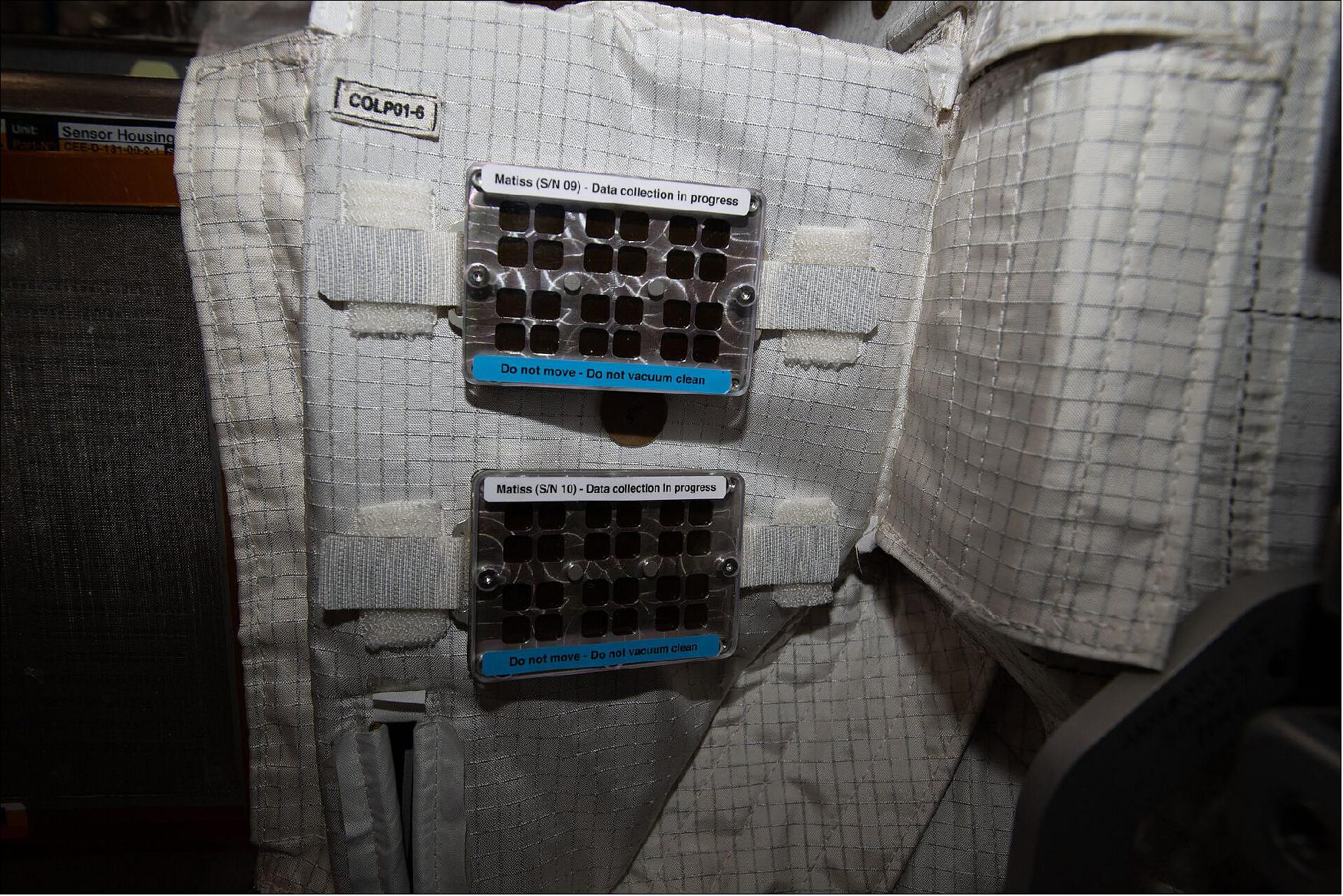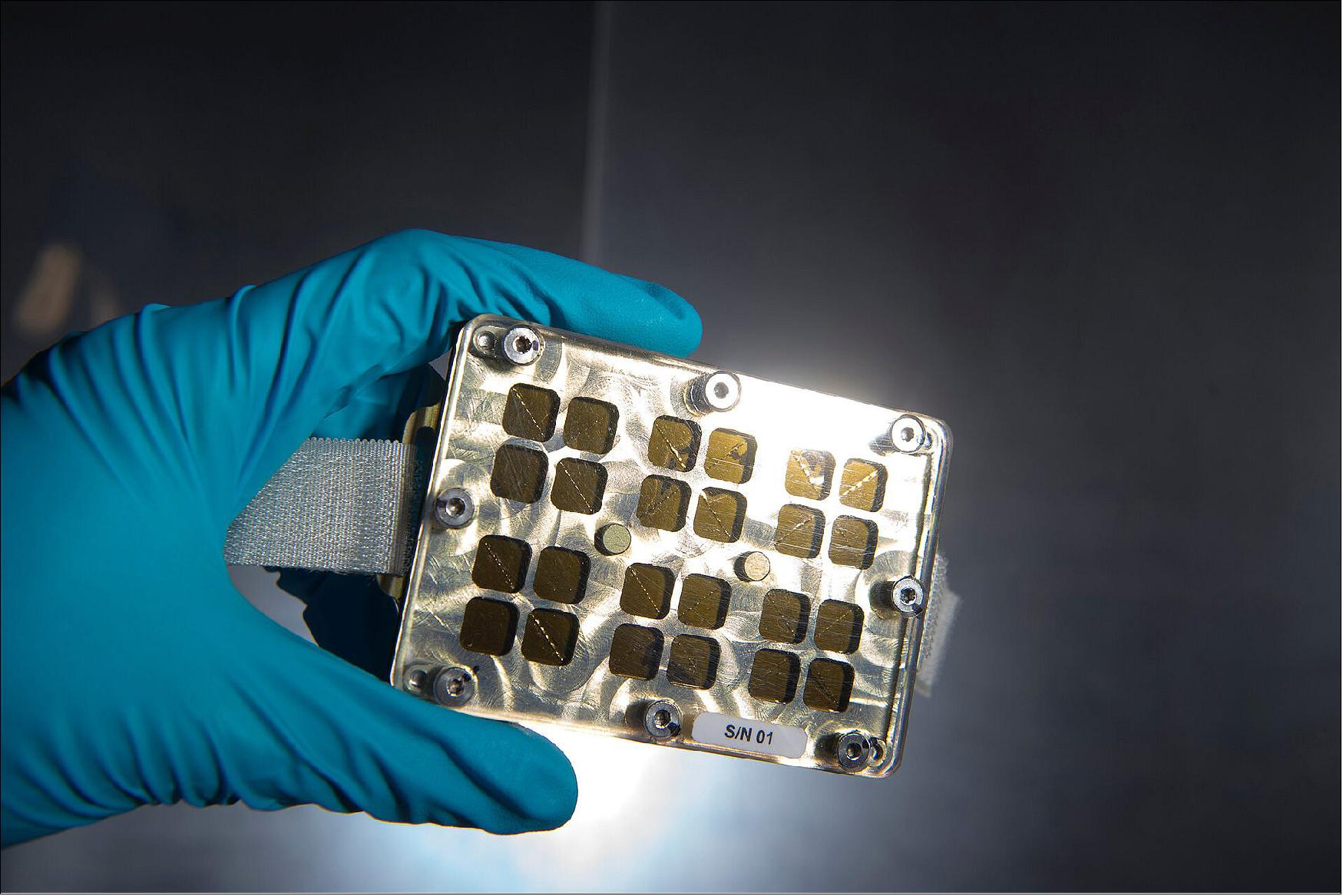ISS: MATISS
Science
ISS Utilization: MATISS (Microbial Aerosol Tethering on Innovative Surfaces)
The MATISS experiment investigates the antibacterial properties of materials in space and is expected to provide insight into the mechanisms for attachment of biofilms in microgravity conditions. Bacteria tend to build up in the constantly-recycled atmosphere of the space station, and this insight has applications for future space missions. 1)
The first MATISS experiment plaques, launched to the ISS on November 17, 2016 from Baikonur, will test the anti-bacterial properties of materials in space. France’s space agency CNES has selected five advanced materials that should stop bacteria from settling and growing on the surface.
The experiment consists of plaques placed in the European Columbus laboratory and leave for at least three months. France’s CNES space agency, in collaboration with the ENS universityof Lyon, research institute CEA Tech - LETI and construction company Saint-Gobain, selected five advanced materials that could stop bacteria from settling and growing on the surface. A sixth element, made of glass, is used as control material.
Bacteria are a big problem in space as they tend to build up in the constantly-recycled atmosphere of the International Space Station. Matiss aims to find better materials to build a space station or spacecraft with, especially important for longer missions farther from Earth. Researchers will also monitor how bacteria form biofilms that protect them from cleaning agents and help them adhere to surfaces.
Everybody knows a clean house is a healthy place to live, but what if you live on the International Space Station? Air and water are constantly recycled and waste can only be removed when a spacecraft departs for Earth every few months. For the six astronauts living in humanity’s habitat in space, keeping the Station clean is an important part of their life to avoid bacteria and fungus. Every Saturday is cleaning day, when the whole crew wipe surfaces, vacuum and collect waste.
The materials are a diverse mix of advanced technology – from self-assembly monolayers and green polymers to ceramic polymers and water-repellent hybrid silica. The smart materials should stop bacteria from sticking to the surface and growing, effectively making them easier to clean and more hygienic – but which one works best?
The units are open on the sides to let air flow naturally through and collect any bacteria floating past.
Future long-duration human spaceflight calls for developments to limit biocontamination of the surface habitats. The MATISS experiment tests surface treatments in the ISS’s atmosphere. Four sample holders were mounted with glass lamella with hydrophobic coatings, and exposed in the Columbus module for ~6 months. About 7800 particles were detected by tile scanning optical microscopy (x 3 and x 30 magnification) indicating a relatively clean environment (a few particles per mm2), but leading to a significant coverage-rate (>2% in 20 years). Varied shapes were displayed in the coarse (50–1500 µm2) and fine (0.5–50 µm2) area fractions, consistent with scale dices (tissue or skin) and microbial cells, respectively. The 200–900 µm2 fraction of the coarse particles was systematically higher on FDTS and SiOCH than on Parylene, while the opposite was observed for the <10 µm2 fraction of the fine particles. This trend suggests two biocontamination sources and a surface deposition impacted by hydrophobic coatings. 2)
Mission Status
• April 27, 2023: The International Space Station (ISS) partners have agreed to extend the operational period of the ISS. The United States, Japan, Canada and participant European Space Agency (ESA) countries will support operations until 2030, while Russia has committed to continuing station operations until 2028. 6)
• January 19, 2021: A ‘do not touch’ directive applies to both a Matisse painting and this MATISS experiment (Figures 1, 2 and 4) on board the International Space Station. 3)
- The first set of the MATISS experiment plaques, known as MATISS-1, provided some baseline data points for researchers. Four sample holders were set up in three different locations within the European Columbus laboratory, where they remained for six months.
- Once these samples were returned to Earth, researchers characterized the deposits formed on each surface and used the control material to establish a reference for the level and type of contamination expected over half a year.
- A continuation of the experiment, known as MATISS-2, saw four identical sample holders containing three different types of material installed in a single location in Columbus. This study aimed to better understand how contamination spreads over time across the hydrophobic and control surfaces. The upgraded MATISS-2.5 aimed to study how contamination spreads, this time spatially, across the hydrophobic surfaces using patterned samples.

- The materials are a diverse mix of advanced technology – from self-assembly monolayers and green polymers to ceramic polymers and water-repellent hybrid silica. The smart materials should stop bacteria from sticking and growing over large areas, and effectively making them easier to clean and more hygienic – but which one works best?
- Understanding the effectiveness and potential use of these materials will be essential to the design of future spacecraft, especially those carrying humans father out in space.
- The findings could also lead to the development and greater use of antimicrobial surfaces on elevator buttons and door handles, in bars, on public transport and in other high-traffic areas.
• April 3, 2020: While efforts continue to contain the spread of the novel coronavirus on Earth, a space-based experiment called MATISS has been investigating how ‘smart surfaces’ on the International Space Station could stop pathogens in their tracks. 4)
- The experiment examines the performance of five advanced materials in preventing illness-causing microorganisms from settling and growing in microgravity. MATISS (Microbial Aerosol Tethering on Innovative Surfaces) in the international Space Station is driven by the French space agency (CNES) and was commissioned in 2016 during ESA astronaut Thomas Pesquet’s Proxima mission.

- Materials sent to the Space Station were selected for their ability to respond to a given stimulus by repelling microorganisms, preventing their growth, or creating their own biofilms to provide a protective shield. They included a mix of advanced technology, from self-assembly monolayers and green polymers, to ceramic polymers and water-repellent hybrid silica.
- Understanding the effectiveness and potential use of these materials will be essential to the design of future spacecraft, but could also lead to development and greater use of antimicrobial surfaces on elevator buttons and door handles, in bars, on public transport and in other high-traffic areas.
Reducing the Risk
- The confined environment of the International Space Station, where air and water are constantly recycled and waste is stored onboard, is the ideal environment for testing such surfaces.
- Astronauts already undertake a strict period of quarantine prior to launch and carry out regular, thorough cleaning once on Station to reduce the risk of illness and infection. However, surfaces that respond protectively to airborne bacteria would be easier to clean and more hygienic.
Evolution of an Experiment
- The first set of the MATISS experiment, known as MATISS-1, provided some baseline data points for researchers. Four sample holders – each containing the five materials to be tested plus a glass control surface – were set up in three different locations within the European Columbus laboratory, where they remained for six months.
- Once these samples were returned to Earth, researchers characterized the deposits formed on each surface and used the control material to establish a reference for the level and type of contamination expected over half a year.
- A continuation of the experiment, known as MATISS-2, saw four identical sample holders containing three different types of material installed in a single location in Columbus. This study aimed to better understand how contamination spreads across the hydrophobic and control surfaces.
- Sample holders from MATISS-2 were returned to Earth on a SpaceX Dragon spacecraft in August 2019. At that time, NASA astronaut Andrew Morgan also installed a further set of two sample holders in Columbus, which aim to test new patterned hydrophobic (liquid-repelling) surfaces.

LETI (Laboratore d'électronique et de technologie de l'information), an institute of CEA Tech, and three French partners are collaborating in a “house-cleaning” project aboard the International Space Station that will investigate antibacterial properties of new materials in a zero-gravity environment to see if they can improve and simplify cleaning inside spacecraft. 5)
The MATISS experiment, as part of the Proxima Mission sponsored by France’s CNES space agency, is based on four identical plaques that ESA (European Space Agency) astronaut Thomas Pesquet, the 10th French citizen to go into space, will take with him and install when he joins the space station in November for a six-month mission. The plaques will be in the European Columbus laboratory in the space station for at least three months, and Pesquet will bring them back to earth for analysis at the conclusion of his mission.
The experiment will test the new smart surfaces in a gravity-free, enclosed environment. These surfaces are called "smart" because of their ability to provide an appropriate response to a given stimulus. For example, they may repel bacteria, prevent them from growing on the surface, or create their own biofilms that protect them from the bacteria.
The materials are a mix of advanced technology – from self-assembly monolayers and green polymers to ceramic polymers and water-repellent hybrid silica. By responding protectively to air-borne bacteria they become easier to clean and more hygienic. The experiment will determine which one is most effective and could lead to antibacterial surfaces on elevator buttons and bars in mass-transit cars, for example.
"Leveraging its unique chemistry platform, LETI has been developing gas, liquid and supercritical-phase-collective processes of surface functionalization for more than 10 years," said Guillaume Nonglaton, LETI’s project manager for surface chemistry for biology and health-care applications. "Three LETI-developed surfaces will be part of the space-station experiment: a fluorinated thin layer, an organic silica and a biocompatible polymer. They were chosen for their hydrophobicity, or lack of attraction properties, their level of reproducibility and their rapid integration within Pesquet’s six-month mission."
References
1) ”Matiss-2 experiment on the Space Station,” ESA Science & Exploration, 27 May 2019, URL: https://www.esa.int/ESA_Multimedia/Images/2019/05/Matiss-2_experiment_on_the_Space_Station
2) Laurence Lemelle, Lucie Campagnolo, Eléonore Mottin, Denis Le Tourneau, Emmanuel Garre, Pierre Marcoux, Cécile Thévenot, Alain Maillet, Sébastien Barde, Jérémie Teisseire, Guillaume Nonglaton, Christophe Place, ”Towards a passive limitation of particle surface contamination in the Columbus module (ISS) during the MATISS experiment of the Proxima Mission,” npj Microgravity, Volume 6, Article No 29, Published: 20 October 2020, URL: https://www.nature.com/articles/s41526-020-00120-w
3) ”Keep this surface dirty,” ESA Science & Exploration, 19 January 2021, URL: https://www.esa.int/ESA_Multimedia/Images/2021/01/Keep_this_surface_dirty
4) ”Smart surfaces for space hygiene,” ESA Science & Exploration, 3 April 2020, URL: http://www.esa.int/Science_Exploration/Human_and_Robotic_Exploration/Smart_surfaces_for_space_hygiene
5) ”Experiment designed to test 'smart' antibacterial surfaces in space,” Nanowerk, 15 November 2016, URL: https://www.nanowerk.com/nanotechnology-news/newsid=45078.php
6) Garcia, Mark. “Partners Extend International Space Station for Benefit of Humanity – Space Station.” NASA Blogs, 27 April 2023, https://blogs.nasa.gov/spacestation/2023/04/27/partners-extend-international-space-station-for-benefit-of-humanity/
The information compiled and edited in this article was provided by Herbert J. Kramer from his documentation of: ”Observation of the Earth and Its Environment: Survey of Missions and Sensors” (Springer Verlag) as well as many other sources after the publication of the 4th edition in 2002. - Comments and corrections to this article are always welcome for further updates (eoportal@symbios.space).